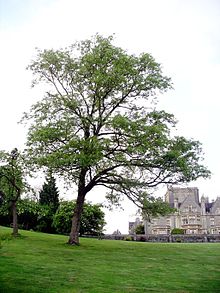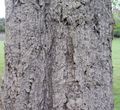- Quercus variabilis
-
Chinese Cork Oak 
Chinese Cork Oak planted at Tortworth Court, England Scientific classification Kingdom: Plantae (unranked): Angiosperms (unranked): Eudicots (unranked): Rosids Order: Fagales Family: Fagaceae Genus: Quercus Section: Cerris Species: Q. variabilis Binomial name Quercus variabilis
Bl.Quercus variabilis (Chinese Cork Oak) is a species of oak in the section Quercus sect. Cerris, native to a wide area of eastern Asia in China, Japan, and Korea.
Contents
Description
It is a medium-sized to large deciduous tree growing to 25-30 m tall with a rather open crown, and thick corky bark with deep fissures and marked by sinuous ridges. The leaves are simple, acuminate, variable in size, 8-20 cm long and 2-8 cm broad, with a serrated margin with each vein ending in a distinctive fine hair-like tooth; they are green above and silvery below with dense short pubescence.
The flowers are wind-pollinated catkins produced in mid spring, maturing about 18 months after pollination; the fruit is a globose acorn, 1.5-2 cm diameter, two-thirds enclosed in the acorn cup, which is densely covered in soft 4-8 mm long 'mossy' bristles.
-
Chinese Cork Oak planted at Meise, Belgium
Distribution and habitat
Evergreen and deciduous forests; below 3000 m. Anhui, Fujian, Gansu, Guangdong, Guangxi, Guizhou, Hebei, Henan, Hubei, Hunan, Jiangsu, Jiangxi, Liaoning, Shaanxi, Shandong, Shanxi, Sichuan, Taiwan, Yunnan, Zhejiang Japan, Korea.[1]
Uses
It is cultivated in China to a small extent for cork production, though its yield is lower than that of the related cork oak. It is also occasionally grown as an ornamental tree.
Notes
- ^ eFloras, 2009
References
- eFloras, Missouri Botanical Garden & Harvard University Herbaria (FOC Vol. 4 Page 372), Quercus variabilis, http://efloras.org/florataxon.aspx?flora_id=2&taxon_id=200006306, retrieved 2009

This Fagales article is a stub. You can help Wikipedia by expanding it.



